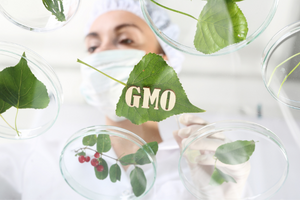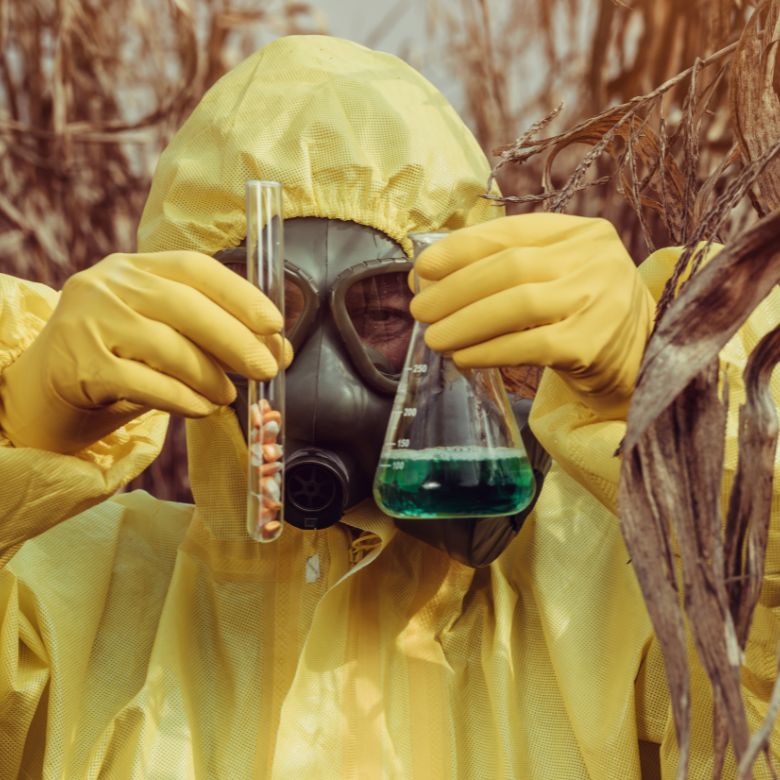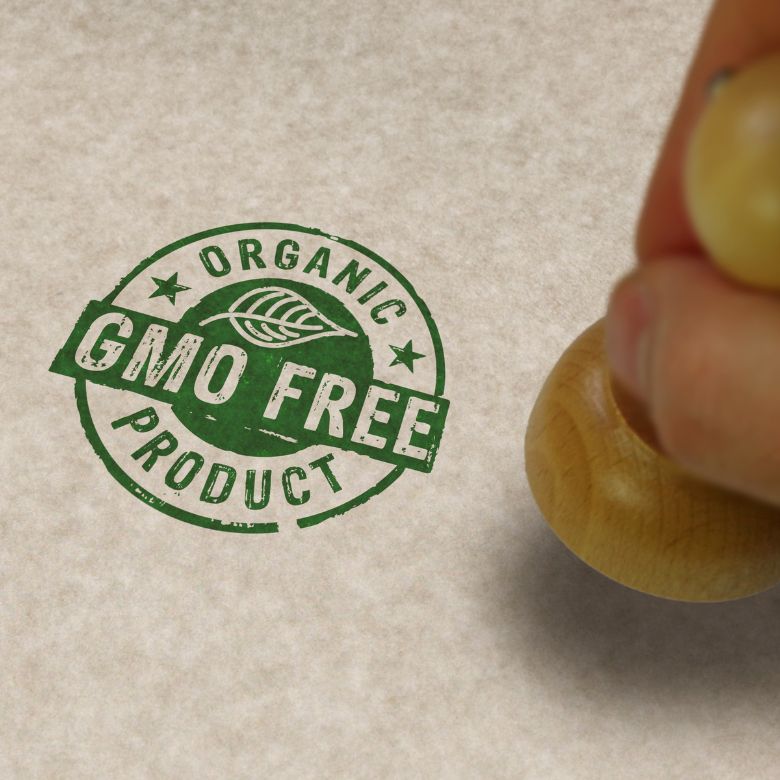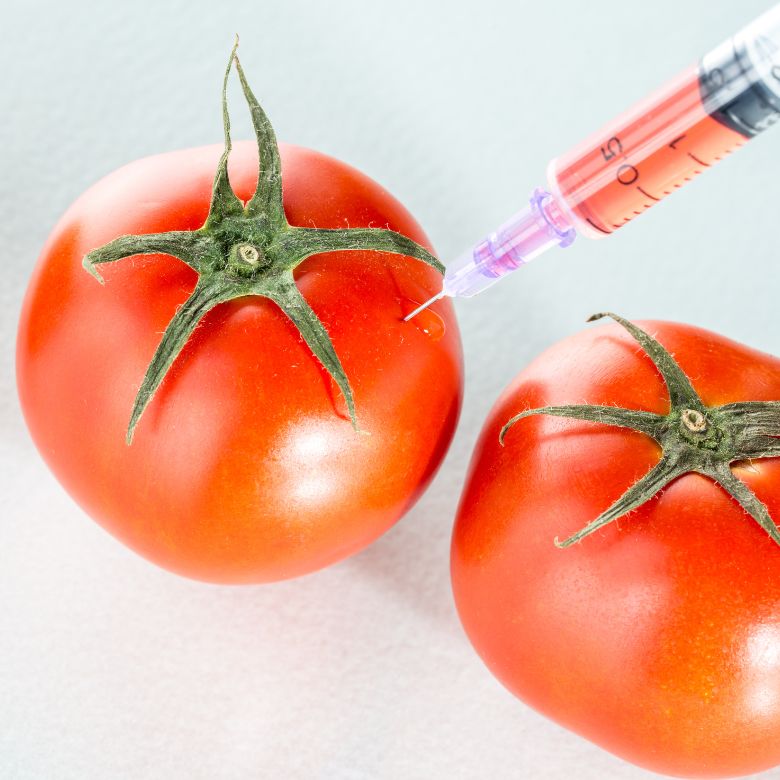Genetic engineering is a biological science that deals with, among other things, the processes of directed gene exchange between organisms using biotechnological methods.
It is a relatively new field, highly controversial in terms of safety for the environment as well as for human health and life. Public support for organisms with modified genomes is low, although there is a noticeable trend towards acceptance of GMOs in some industries. This applies mainly to sectors that work to improve human health and life.

The first organisms modified through genetic engineering were developed in the 1970s. It was a breakthrough that started the use of GMOs in agriculture, cosmetics, food, pharmacology, and medicine.
The aim of introducing genetically modified organisms into mass production was primarily to make pesticide-free agricultural cultivation more profitable. But because of this, the advantages of GMO crops are strongly contested in favour of theories of there being harm to ecosystems and human health.
The topic of GMOs is all the more controversial due to the fact that genetically modified plants and their products are found not only in food. GMO-based raw materials are often used in the mass production of cosmetics.
What actually are GMOs?
GMOs (genetically modified organisms) are organisms whose genomes have been artificially modified using genetic engineering methods in order to obtain new physiological characteristics of those organisms or to alter some existing characteristics.
Contrary to popular belief, genetic modifications are not an entirely artificial phenomenon. Are all genetic manipulations bad in principle? Are genetic modifications completely against nature?
The opinions of some fierce opponents of genetic modifications largely contradict the available scientific evidence. Nature itself spontaneously modifies the DNA of different kinds of organisms under the influence of various stimuli and changes in the environment, adapting those living creatures to function under the changing conditions.
The most basic modifications include, for example, selecting and multiplying specific plant lines that have the highest nutritional potential. Other examples of genetic modifications include crossing and creating the so-called polyploids, i.e., plant organisms that have a multiplied amount of genetic material. Today, it is to such modifications that we owe large ears of grain, juicy and sweet watermelons, and banana flesh with a creamy texture.
Here it can certainly be said that modifications have panned out well. The real controversy arises when we are talking about GMOs in the literal sense, with real manipulation within the genome of a cell.
This requires the intervention of genetic engineering specialists and specialised laboratories with appropriate equipment.
So what is genetic modification? In simple terms, it is the removal of a specific fragment of DNA from an organism, or the insertion of a specific fragment of DNA from a cell of one organism into the genetic material of a cell of another organism.
Which cosmetic raw materials may contain GMOs?
On the market today there is a very wide range of ingredients and additives for use in the production of cosmetics. These substances are mainly of plant origin.
As we all know, industrial production of plants involves large-scale cultivation, where enormous emphasis is placed on efficiency and productivity per hectare. This is why agricultural plants are often subjected to various genetic modifications leading to a greater yield and better quality of crops.
Here are some of the most often genetically modified plants used to produce cosmetic raw materials and additives:
– corn (oil, starch),
– wheat (starch),
– cotton (seed oil),
– apples (organic acids, Proteol APL),
– sugar cane (sugars, squalane),
– rapeseed (oil),
– linseed (oil),
– soybean (oil and wax, phytoestrogens),
– alfalfa (extracts),
– cloves (essential oil),
– eucalyptus (essential oil),
– rose (essential oil),
– melon (extracts),
– papaya (extracts, enzymes),
– plum (extracts),
– poplar (extracts),
– rice (oil, starch),
– tobacco (extracts),
A noteworthy example of a cosmetic raw material that can be derived from GMOs is lauric acid, which is one of the saturated fatty acids. Due to its excellent moisturising properties, it is a raw material often used as an ingredient in personal care products (bathing liquids and soaps, shampoos) and ‘white cosmetics’ for skincare such as creams and moisturising lotions. This compound is extracted from coconuts as well as from rapeseed.
The cosmetic industry’s huge demand for lauric acid was one of the reasons why rapeseed was subjected to genetic modifications. This was done in order to increase the lauric acid content in the plant. Obviously it reduced the price and increased availability, but most of this raw material fits the description of a GMO.
Other common cosmetic ingredients produced from GMOs include corn starch, xanthan gum, glycerol, plant proteins, even vitamins C and E.
When shopping for cosmetics, opponents of GMOs should be aware that products containing the above substances may be made from genetically modified plants.

How to avoid GMO-based cosmetics?
The best choice in this case will be organic cosmetics based on natural ingredients. Such products should contain at least 95% ingredients of natural origin. In addition, the words GMO FREE (or a similar designation) should be on the label.
Labelling of cosmetic products as GMO free is not regulated by law. Some manufacturers use the GMO FREE labelling as one of their marketing tricks to persuade the customer to buy their product.
Usually, cosmetics that are in truth GMO-free have a certification such as ECOCERT, EkoZnak, NaTrue, EcoControl, or EcoGarantie.
What are the advantages of GMOs?
It is clear that genetic engineering is an inexhaustible source of possibilities limited only by the imagination of geneticists and specialists in biotechnological development. Compared to their unmodified counterparts, modified organisms (depending on the type of genetic modification) have many positive characteristics such as:
- much higher protein and fat content (higher energy value),
- ability to produce vitamins and other valuable components that unmodified organisms do not produce, or produce in very small quantities (e.g., rice supplemented with vitamin A),
- much higher efficiency of cultivation, higher yields per hectare,
- possibility of reducing crop acreage (a higher yield per hectare means a lower need for agricultural land). Thanks to this, deforestation and adaptation of wild areas for agricultural crops is limited.
- high resistance to pesticides used in plant cultivation to control weeds, pests, and disease-causing fungi,
- plants’ ability to produce pest-repellent compounds/substances on their own. This makes it possible to reduce the amount of pesticides (insecticides) used for pest control,
- higher resistance to adverse weather conditions and poor soil quality,
- longer storage and shelf life of crops,
- possibility to produce vaccines and medicines (less expensive substitutes),
- early detection of plant and animal diseases (DNA testing),
- production of biofuels,
- reduction in the problem of food scarcity and hunger around the world.
What consequences can the use of GMOs have?
So what are the disadvantages of GMOs? Opinions and arguments vary. Among the most popular are:
- harmfulness to human health and life (allergies, digestive system diseases, immunity disorders, cancers, infertility),
- uncontrolled release of genetically modified organisms into the environment,
- uncontrolled migration of GMO genes to other organisms within the same or different species (neighbouring crops),
- increased resistance of weeds and pests to pesticides (the need to use ever more powerful plant protection products),
- negative impact on fauna (birds, insects, amphibians, marine animals, organisms living in the soil),
- reduction of biodiversity in nature,
- monopolisation of the seed market,
- harmfulness to plant-pollinating insects.
Proponents of GMOs firmly maintain that there is no evidence of harm from GMOs to the human body. And tests on animals are not sufficiently reliable.
Opponents cite the same argument, but directed against GMOs. According to them, there is a lack of hard, scientific evidence denying the harmfulness of GMOs to the environment and human life, and many indications strongly support their negative impact.
In addition, opponents of GMOs point to very intense political lobbying by global producers of agricultural plant seeds that have been genetically modified. Corporations aim to monopolise global markets and thereby increase profits from the sales of sowable GMO materials.

GMOs – what does science say about them?
GMO technology has been undergoing development for almost fifty years now. It dates back to 1973. To this day, many scientific studies are conducted forming the basis for meta-analyses and extensive semantic reviews. These have allowed scientific conclusions to be drawn, which unequivocally state that cultivation of GMOs and thus also the raw materials produced from them are safe for humans and the environment.
Allegations against GMOs vs. scientific evidence
Long-term impact of GMOs on the environment
In the many years of cultivating various agricultural plants, it has never been unequivocally established that GMO plants show greater harmfulness to the environment or humans compared to conventional crops.
What is more, genetically modified plants are grown using lower doses of pesticides and fertilisers. Also, in terms of agricultural usefulness, GMO plants can be successfully grown on soils of lower quality.
Food and cosmetics that contain GMOs may alter or damage the human genome
The plants we use every day in the form of food and cosmetics have their own DNA, i.e., genetic material. This means that every day we take in a large dose of genetic material from other organisms. The fact is that human cells are not capable of incorporating functional DNA from other organisms, whether genetically modified or not.
Takeover of DNA by the human body from a genetically altered plant is impossible also due to the fact that it gets decomposed by enzymes upon contact with the skin or the inside of the stomach. DNA decomposed down to single nitrogenous bases that make up genes becomes an ordinary food ingredient. Therefore, it is unable to continue to perform its previous functions.
Food and cosmetics containing GMOs may cause allergies
By law, every new genetic modification of plants is tested in terms of causing allergies before being introduced into regular cultivation. For example, a food allergy is an overreaction of the human body to certain ingredients found in food.
More often than not, allergy and sensitisation symptoms are triggered by proteins the allergic person’s body ‘thinks’ are pathogens and tries to fight off. This results in an allergic reaction that can take the form of gastrointestinal complaints, respiratory problems, or skin lesions.
Allergies can therefore be caused by both GMOs and conventionally grown plants, as both contain proteins.
Food and cosmetics containing GMOs pose the risk of cancer
In 2012, a study was published according to which feeding rats with genetically modified corn grown using a pesticide called glyphosate caused tumours in these animals.
The author of that study was Gilles-Éric Séralini, a French molecular biologist who is one of the staunchest opponents of GMOs. The professor was rather quickly proven wrong in his research, including with regard to methodology. The scientist conducted tests on breeds that are susceptible to cancer. Also, he did not use a control group. The scientific community considered this to be a cardinal error because the lack of a control group does not provide a reference point. This, of course, entails the impossibility of reliably assessing an increase or decrease in the frequency of any specific consequence.
Another error of the professor were the insufficiently large test groups. In other words, his calculations did not have a reliable statistical effect. The scientist’s publication was eventually retracted as an unreliable scientific source.
Unfortunately, Séralini’s findings continue to this day to be the main argument of fierce opponents of GMOs. Proponents, on the other hand, have on their side the many years of reliable studies proving the absence of a carcinogenic potential in genetically modified plants and thus of raw materials derived from them, including cosmetic raw materials.
Moreover, some genetic modifications have the ability to reduce human exposure to carcinogens. Examples include modified corn varieties resistant to mould fungi and harmful aflatoxins.
GMOs kill beneficial insects that pollinate plants
New-generation plant metabolites have the ability to act selectively. As a result, they control pests while not showing even the slightest harmful effect on honeybees. Some substances produced from genetically modified plants do not get into the pollen or nectar. Other GMO derivatives, despite being found in pollen, are completely harmless to bees and other species of animals, except for pests that attack agricultural plants.
GMOs lead to an increased use of pesticides
The very idea of GMOs assumes reducing, not increasing, the use of pesticides in plant cultivation. GMO crops are meant to be more resistant to weeds, pests, and diseases, compared to conventional plants.
Creation of genetically modified plants actually protects crops from various pathogens without harming any beneficial organisms.
Most modified plant lines demonstrate high resistance to herbicides, i.e., weed killers. In practice, this means that herbicide treatments are not harmful to the crops, while they selectively destroy weeds.
However, overuse of pesticides in plant cultivation means that, as time passes, weeds become resistant to chemicals, becoming species that are extremely difficult to control. This is a dangerous phenomenon, especially as in some regions of the world (e.g., the U.S.) herbicide use is increasing year on year.
So the emergence of ‘superweeds’ is wrongly attributed to GMO varieties, while the continuous increase in the use of certain pesticides can have a negative impact on plants, soil, and water quality/purity.

Harmfulness of GMOs in cosmetics and in the raw materials used to make them
As you already know, the harmfulness of GMOs is still not scientifically proven to be due to gene mutations, because even altered DNA of plants does not affect the DNA of humans. But it is a fact that excessive doses of herbicides and the allergenic insecticidal substances produced by GMOs can be harmful.
In practice, all raw materials and additives used in cosmetics must be approved for production on the basis of strict tests confirming they are safe for human health and life.
Manufacturers of cosmetic raw materials and finished products are obliged to meet strict requirements laid down in legal regulations and standards. Heavy financial penalties are imposed for violating them. So the decision which products to use – GMO FREE or GMO INSIDE – depends solely on the personal preferences of consumers.
A number of GMO FREE cosmetic raw materials can be purchased from PCC Group. The company supplies substances and additives for the production of cosmetics to customers from all over the world. Among other things, they often require that any contained chemical compounds should be GMO-free.
PCC Group’s production companies that manufacture the cosmetic raw materials and additives must design and implement new products with the environment and safety to human health and life in mind.
Manufacturers who operate within the Group are constantly improving existing formulations, introducing new products, using sustainable raw materials for production, and implementing environmentally friendly technologies.
Every product they enter onto the market has individual technical documentation and is subject to obligatory industry-specific research and testing. What is more, cosmetic raw materials that fall into the category of surfactants are manufactured in EFfCI GMP-certified systems (Good Manufacturing Practices in accordance with guidelines from the European Federation for Cosmetic Ingredients).
Do GMOs make any sense?
GMOs are still a topic of much controversy. The truth is that we are confronted with GMO technology every day, whether we are for or against it.
Bacteria, fungi, and substances derived from plants are being subjected to genetic modifications. Thanks to GMOs, many valuable and often life-saving substances are produced on an industrial scale. Examples include insulin and the active ingredients of many medicines. GMOs also enable us to obtain enzymes for use in medicine, pharmaceuticals, and even the production of detergents. On top of it all, GMO crops reduce the use of pesticides, obviously to the benefit of the environment.
But anything artificially modified still arouses distrust, all the more so when it is complicated and not fully understood. In the world of science, nothing is certain. New theories, studies, and discoveries are constantly coming to light, and scientists have ever more spectacular research methods at their disposal. What is scientifically confirmed today may turn out to be no longer relevant tomorrow.
So should I use GMO-based cosmetics or choose GMO FREE products? Science says ‘yes’, but there are still many opponents who issue harsh statements declaring the harmfulness of GMOs. The decision is therefore up to the consumer, who makes their daily choices based on the arguments they know that reflect their current knowledge, worldview, or culture.
————————————————————————————————————————-
Absence of harmful effects of GMO-based substances contained in food and cosmetics is confirmed by: WHO (World Health Organisation), EFSA (European Food Safety Authority), PAN (Polish Academy of Sciences), AMA (American Medical Association), Pontifical Academy of Sciences, French Academy of Sciences, Chinese Academy of Sciences, International Council for Science, and many other national/international scientific associations.
Literature:
https://piorin.gov.pl/files/userfiles/giorin/wn/gmo/broszury/1.pdf
https://vanilablends.pl/rosliny-i-surowce-gmo-w-kosmetykach/
http://www.ilenatury.pl/index.php/2020/08/11/trendy-zywieniowe-w-kosmetykach/
https://biotechnologia.pl/biotechnologia/drobnoustroje-gmo-w-przemysle,17926
https://codziennikkosmetyczny.pl/2017/06/26/gmo-produktach-kosmetycznych/
https://www.europarl.europa.eu/news/pl/headlines/society/20151013STO97392/6-rzeczy-ktore-warto-wiedziec-o-gmo
https://vanilablends.pl/rosliny-i-surowce-gmo-w-kosmetykach/
